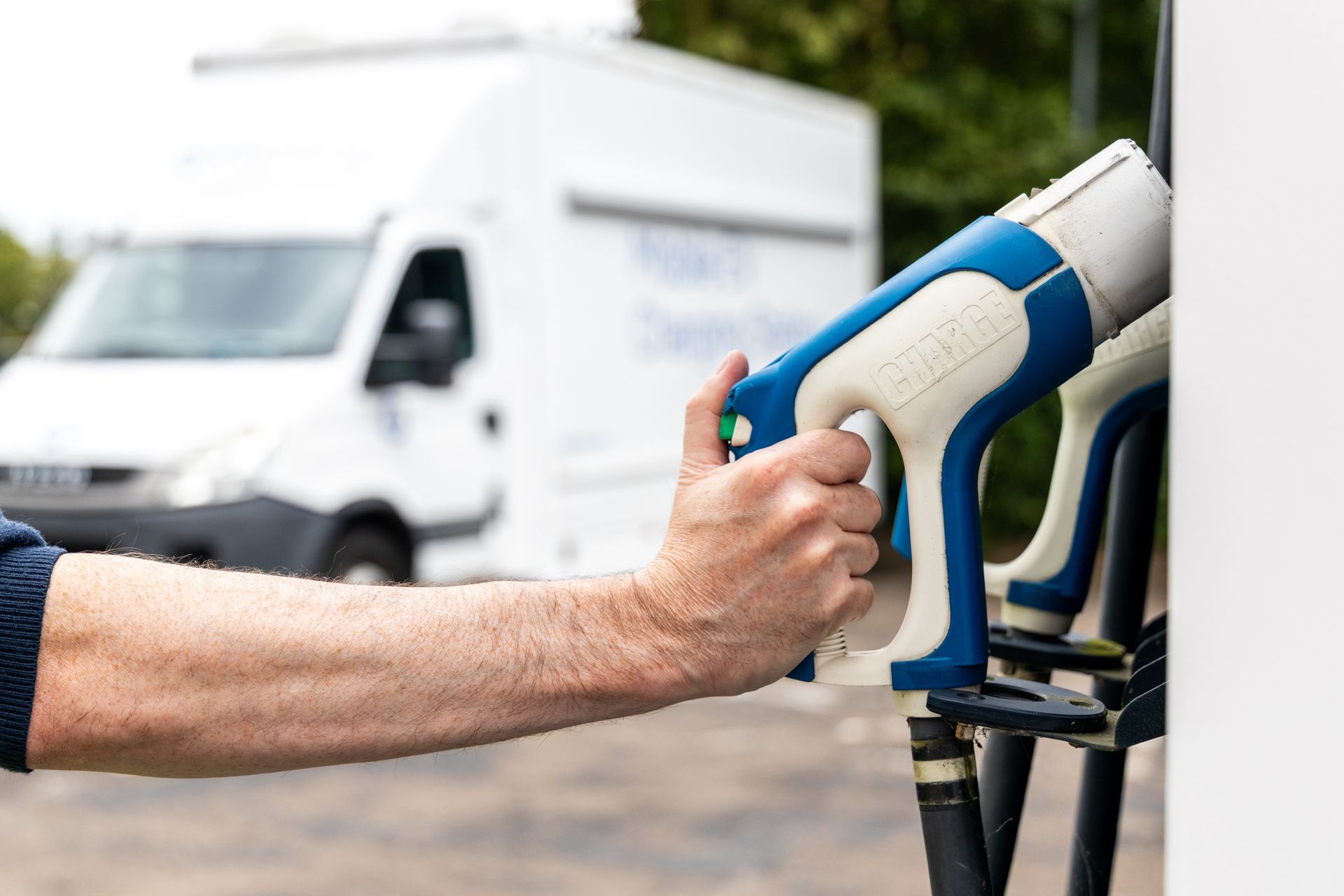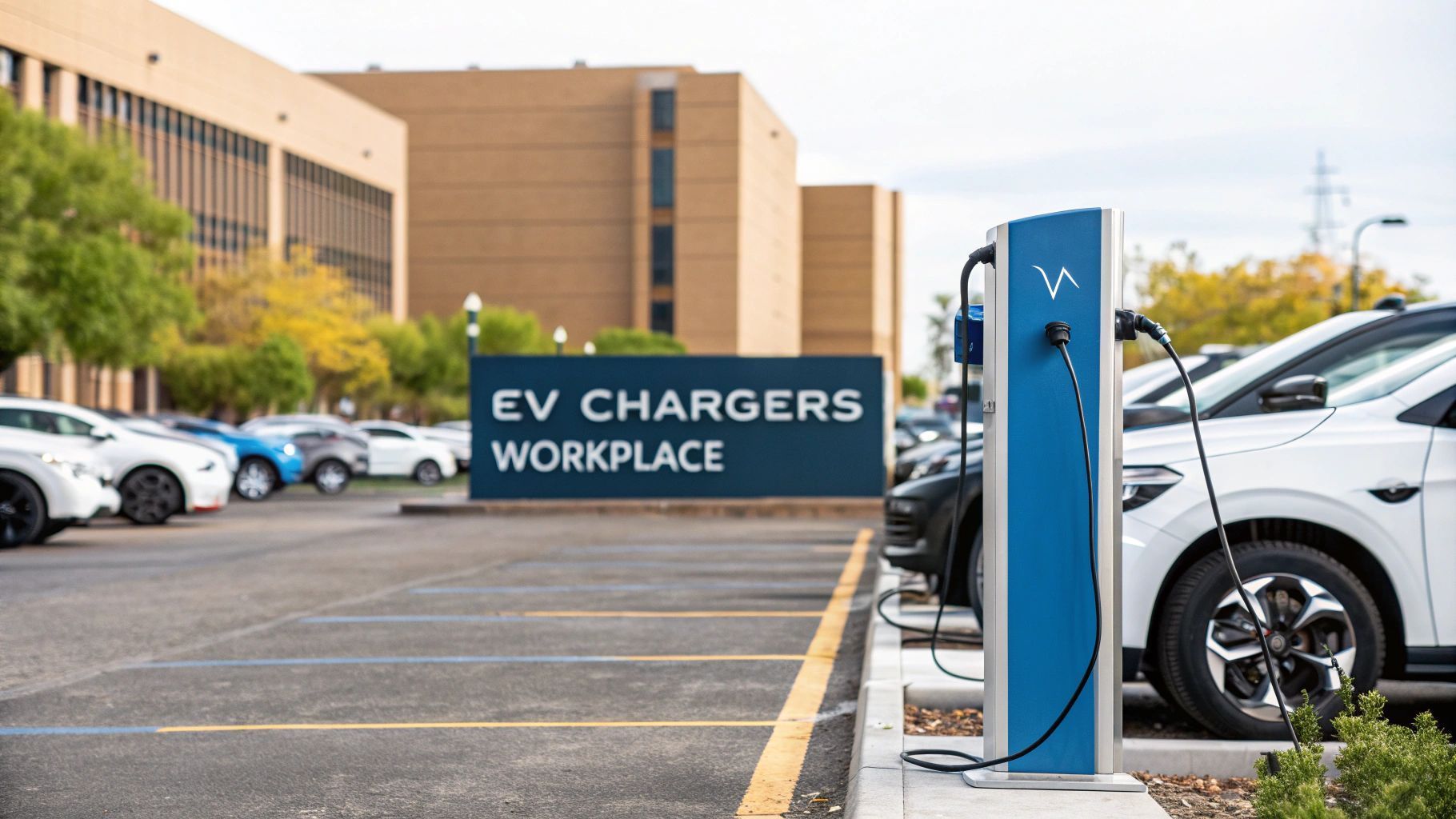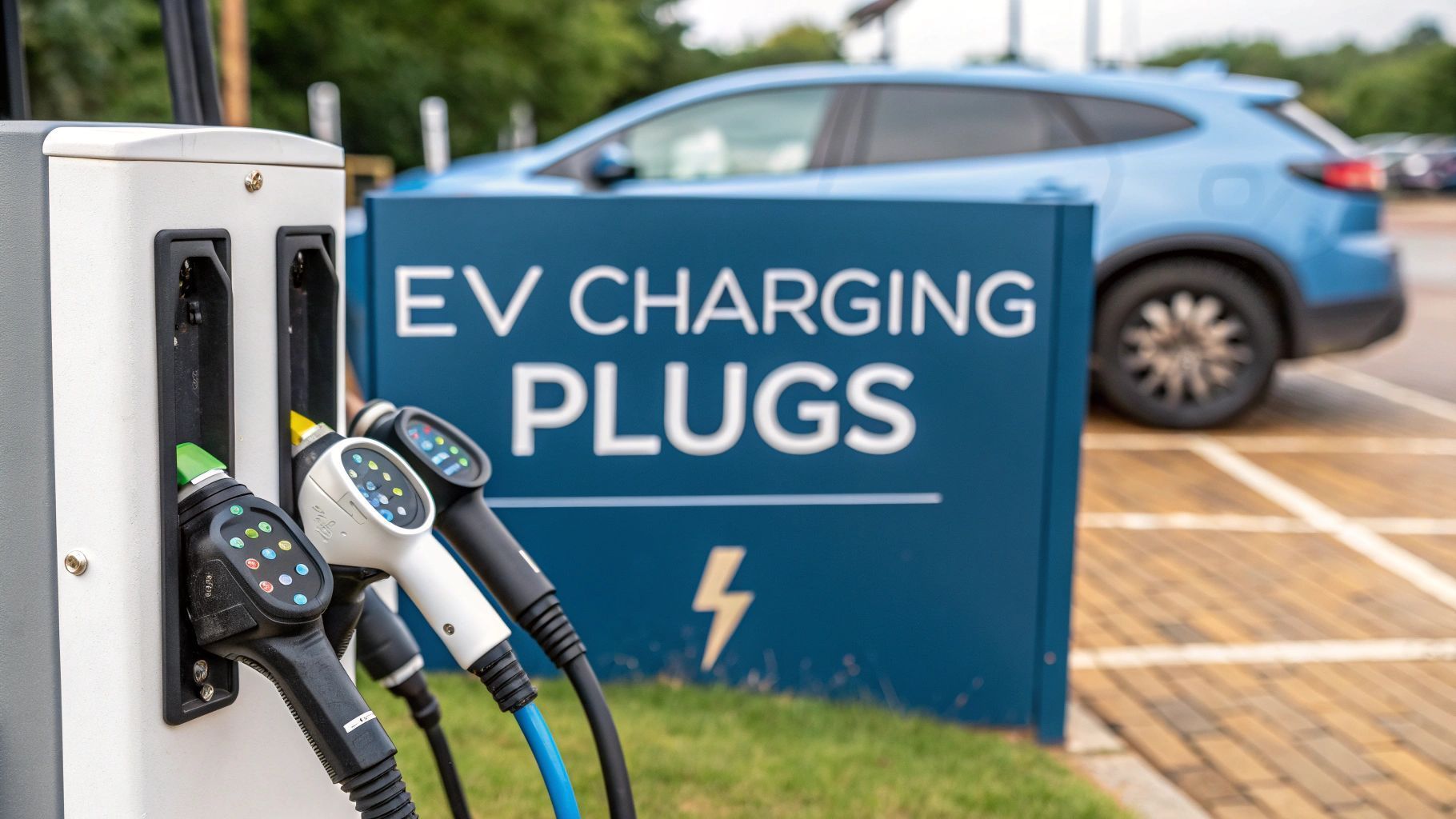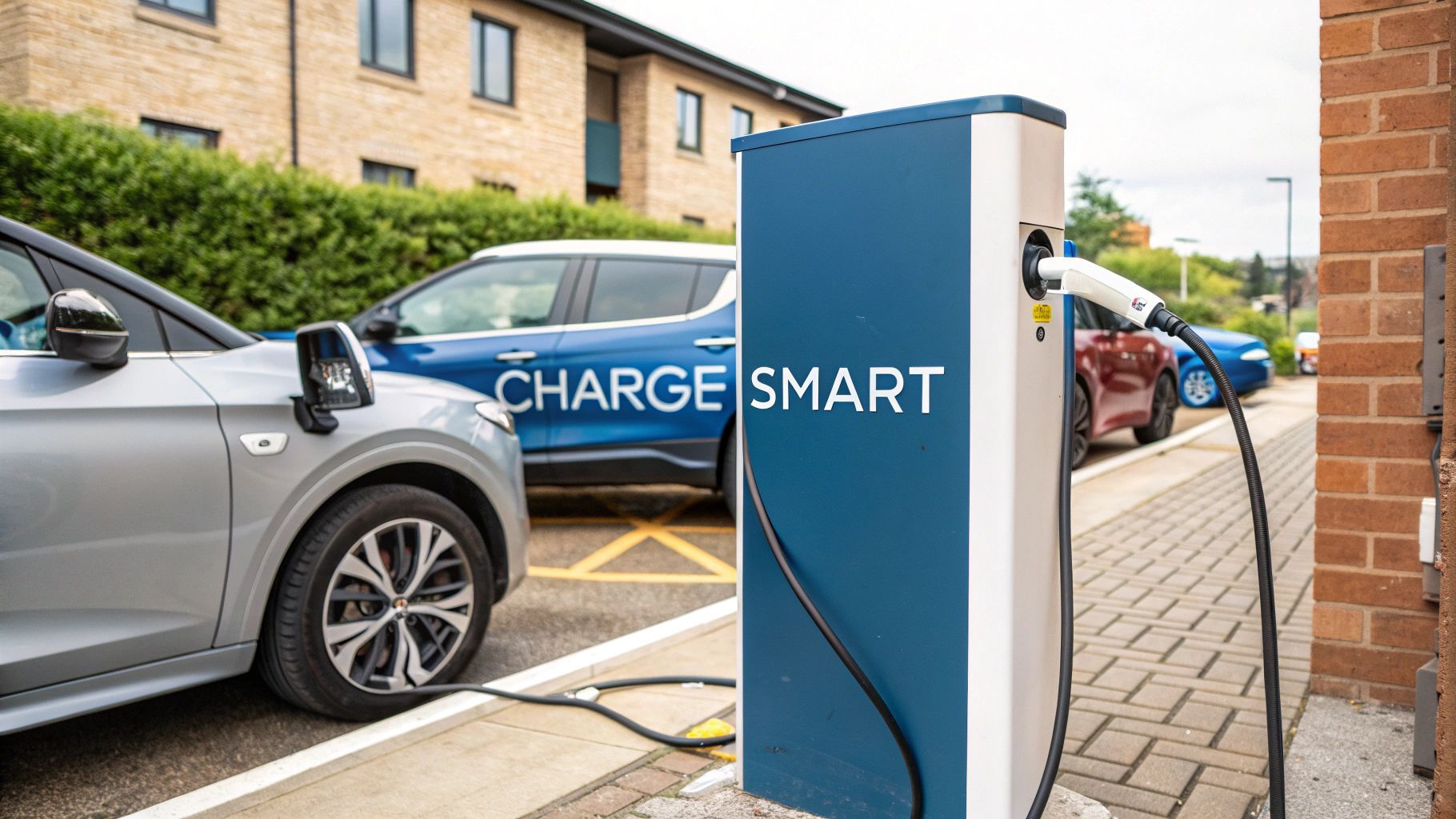Electric Car Charging Plugs: Your Ultimate Guide
Stepping into the world of electric vehicles can feel like learning a new language, especially when it comes to charging. Don’t worry, we’ve got you covered.
Think of it like the early days of mobile phones when every brand had its own unique charger. The EV world has gone through a similar phase but thankfully things are now much more standardised, particularly here in the UK.
Your Guide to Electric Car Charging Plugs in the UK
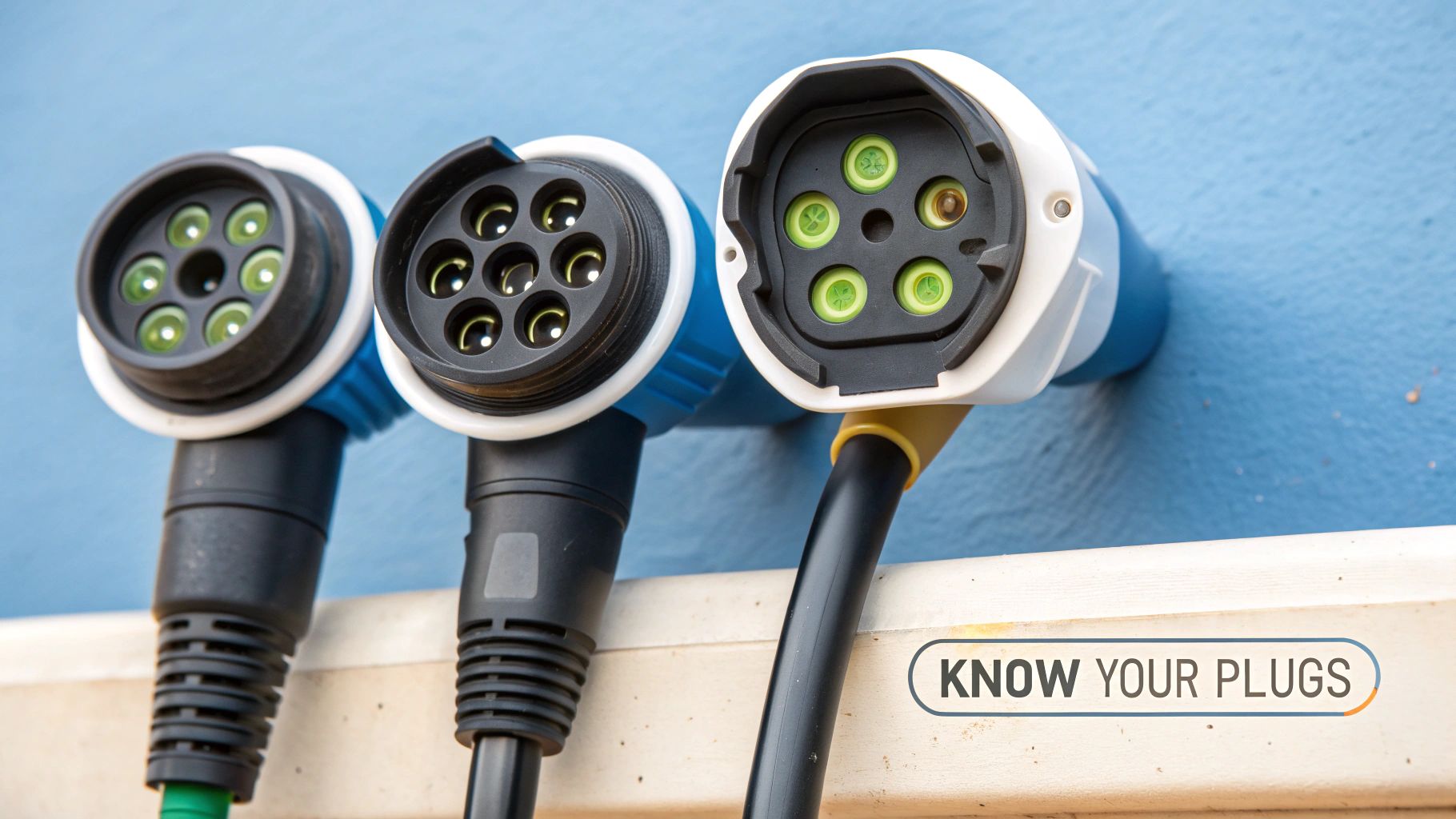
So, you’ve got an electric car or you're thinking of getting one. Fantastic. One of the first things you'll need to get your head around is the different plugs used to get power into the battery. It might seem a bit technical at first but it’s actually quite straightforward once you know the basics.
The reason for the variety is simple: different manufacturers and regions initially backed different technologies. Over time the UK and Europe have settled on a core set of connectors for both slower 'destination' charging (at home or the supermarket) and the super-fast top-ups you need on a long journey. Learning to spot the main plugs is the first step to becoming a confident EV owner.
The Main UK Plug Types
In the UK your charging life will revolve around three main connector types. Each one is designed for a different job, mainly related to charging speed and the car you drive.
Let's break them down:
- Type 2: This is the undisputed standard for AC charging. You'll find it on almost every new electric car and home charger. It’s your go-to for overnight charging at home, topping up at work or grabbing some juice while you’re at the shops.
- CCS (Combined Charging System): Meet the champion of rapid charging in the UK and Europe. The CCS plug is a clever bit of kit that builds on the Type 2 connector by adding two large pins underneath it for high-speed DC power. This is the plug you'll be using at most motorway service stations for a quick charge.
- CHAdeMO: This is an older rapid charging standard, championed mainly by Japanese brands like Nissan and Mitsubishi. You'll still see CHAdeMO chargers around but it’s becoming less common on new cars sold in the UK as most manufacturers have shifted to CCS.
For a quick reference, here's how they stack up.
UK Electric Car Charging Plugs at a Glance
This table gives you a simple overview of the connectors you'll commonly find across the UK.
| Plug Type | Typical Use | Charging Speed (Power) |
|---|---|---|
| Type 2 | Home, workplace, and public AC charging | 3.6kW – 22kW |
| CCS | Public rapid and ultra-rapid DC charging | 50kW – 350kW |
| CHAdeMO | Public rapid DC charging (less common now) | 50kW – 100kW |
Knowing which plugs your car uses is the key to stress-free electric driving.
Understanding your vehicle's connectors is fundamental. It dictates which public chargers are available to you and what kind of home charger you should install. Getting this right from the start means you’re always prepared, whether you're charging overnight or stopping for a quick boost on the motorway.
Once you know the difference between these plugs, you'll be able to spot the right charger for your car in a heartbeat. If you want to dive deeper into making sure your car and charger are a perfect match, our guide on EV charging compatibility has all the details you need.
Everyday AC Charging Plugs for Home and Work
Most of the time you’ll be charging your electric car while you’re busy doing something else—sleeping, working or doing the weekly shop. This is the world of AC (Alternating Current) charging which uses a slower, steadier flow of power that’s perfect for these day-to-day top-ups.
For this job there are two main players in the world of electric car charging plugs: Type 1 and Type 2 .
Think of the difference between them like an old, clunky phone charger versus a modern USB-C cable. Both get the job done but one has clearly become the standard for new devices thanks to its better design and versatility. In the UK and Europe that standard is the Type 2 plug.
The Reigning Champion: Type 2
The Type 2 connector, sometimes called a Mennekes plug, is the standard for virtually every new electric car sold in the UK and across Europe today. Its robust, seven-pin design is built to handle both single-phase power for home charging and more powerful three-phase electricity for faster public AC points.
This versatility is its greatest strength. It means the same socket on your car works for a slow overnight charge from a 3.6kW home wallbox or a much quicker top-up at a supermarket, where chargers can deliver up to 22kW . It’s a one-size-fits-all solution for everyday charging.
What About the Type 1 Plug?
The Type 1 plug, often known by its technical name J1772, was an earlier standard used mainly by some Asian and American car manufacturers. You’ll still find it on older models like the first-generation Nissan Leaf or on vehicles imported from regions where it was more common.
Its five-pin design is limited to single-phase power which means its charging speed typically maxes out at around 7.4kW . While it’s perfectly functional the industry has firmly moved towards Type 2. You’ll rarely see a public charging station with a tethered Type 1 cable anymore.
If you own a car with a Type 1 socket you'll usually need a special cable to connect to the now-standard Type 2 outlets. In those cases it’s worth knowing how to find the best electric car charger adapter in the UK to make sure you’re never caught out.
The crucial takeaway is this: Type 2 is the present and future for AC charging in the UK. If you're buying a new EV, it will almost certainly have a Type 2 socket, making home and public charging simple and consistent.
The infographic below shows how these different AC plugs and power levels translate into real-world range added per hour.
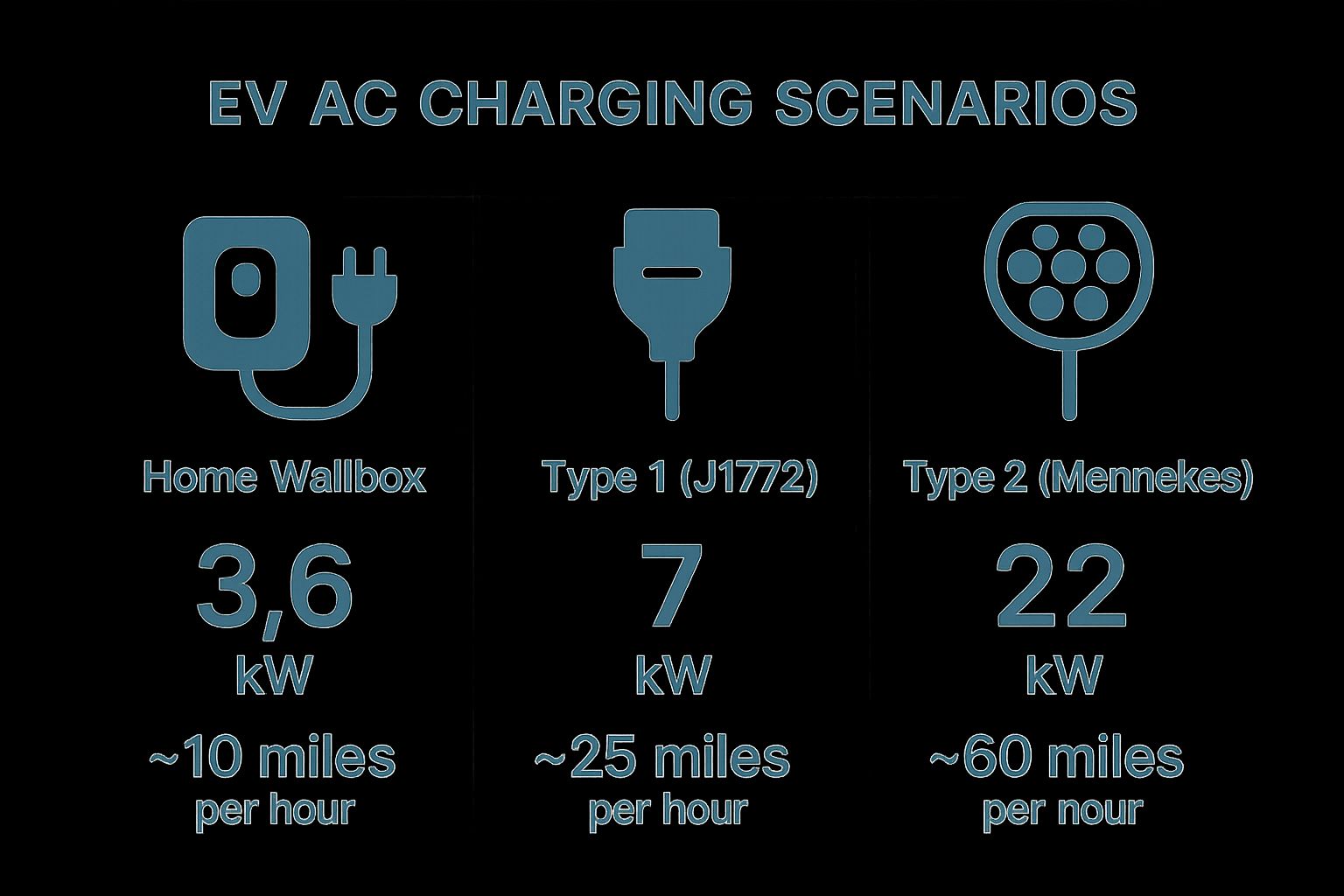
As you can see, even a basic home wallbox adds a useful amount of range overnight. A more powerful public Type 2 charger, on the other hand, can give you a significant boost in just an hour. Understanding these speeds helps you plan your charging around your daily routine seamlessly.
Rapid DC Charging for Long Journeys
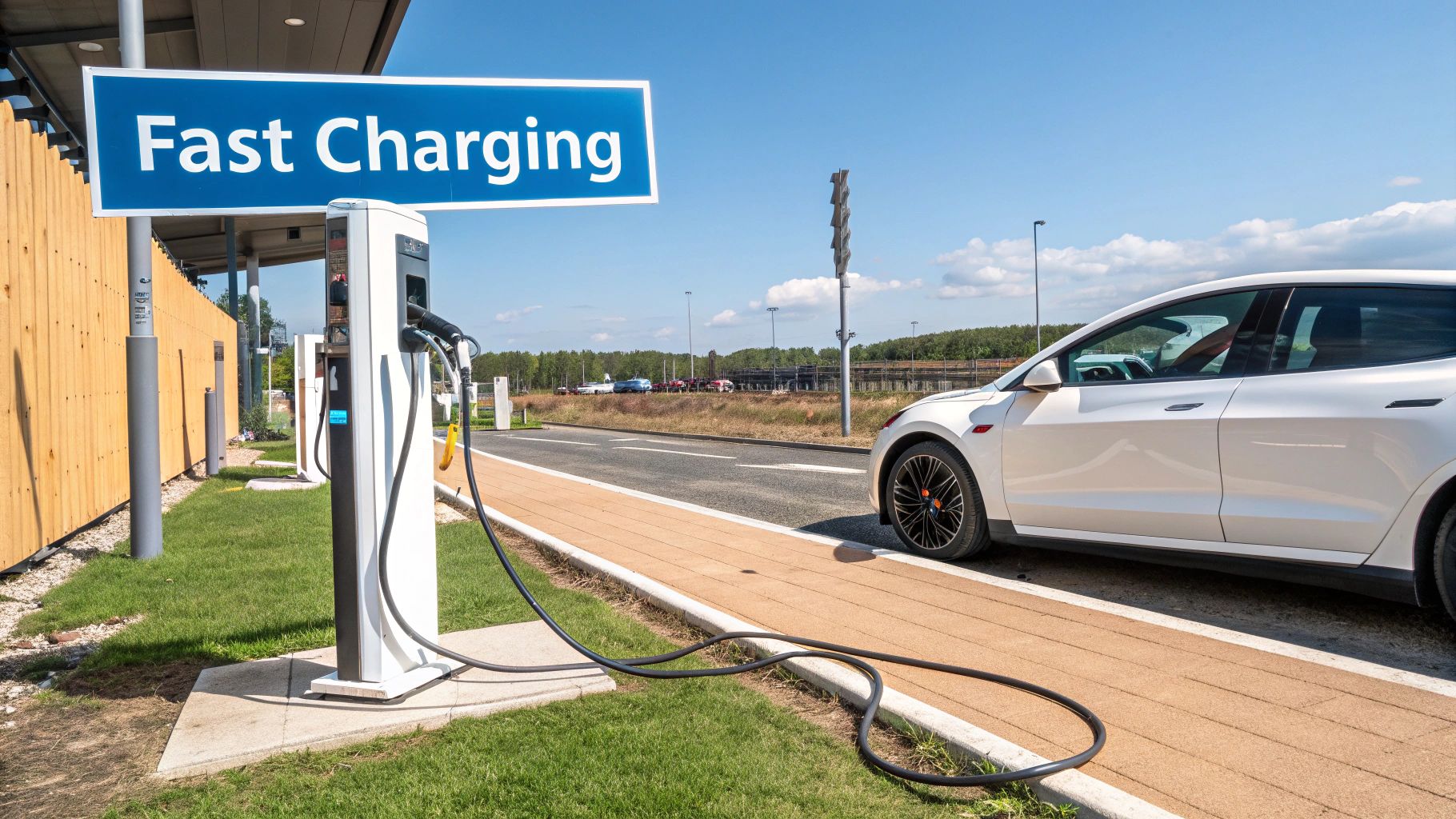
While slower AC charging is perfect for a full battery overnight it’s no use when you’re halfway up the M6 and need to get back on the road. This is where DC (Direct Current) rapid charging comes in, delivering a powerful jolt of energy that can add hundreds of miles of range in the time it takes to grab a coffee and stretch your legs.
Pull up to any motorway service station and you’ll likely see two main types of rapid charging plugs dangling from the units: CCS (Combined Charging System) and CHAdeMO . Think of them as the high-speed fuel pumps for the electric age. Getting your head around the difference is essential because your car will only work with one of them.
CCS: The All-in-One Standard
The CCS plug is now the undisputed king of rapid charging across the UK and Europe. It’s a clever bit of engineering, essentially a standard Type 2 connector with two chunky DC pins tacked on underneath. This ‘combined’ design means your car only needs a single, neat charging port for both slow AC top-ups and lightning-fast DC blasts.
This convenience is a huge part of why it’s been adopted by virtually every European and American manufacturer, from Volkswagen and BMW to Ford and even Tesla (for their European models). It just simplifies everything. When you pull up to a CCS charger you use the whole combined plug which covers both the top AC section and the bottom DC pins of your car’s socket.
CHAdeMO: The Japanese Pioneer
CHAdeMO is the other rapid charging standard you’ll see. It was championed early on by Japanese manufacturers like Nissan and Mitsubishi. Unlike the slick, integrated design of CCS, CHAdeMO requires its own separate, large round socket on the car, meaning you’ll have one flap for AC charging and another for DC.
You’ll still find plenty of CHAdeMO connectors at charging stations across the UK, mainly to support the huge number of older Nissan Leafs still on the road. The tide has turned though. Even the Japanese brands are now fitting their new cars for the European market with CCS ports, cementing CHAdeMO’s status as a legacy standard.
The single most important thing for any EV driver is to know which DC plug their car uses before setting off on a long trip. Rocking up to a charger only to find the plug doesn’t fit is a rookie mistake you only make once.
Speed and The Shift in Dominance
The power of these DC chargers, measured in kilowatts (kW), is on another level compared to AC. A typical rapid charger starts at 50kW which is enough to add around 100 miles of range in about 30 minutes. But the network is evolving fast with ultra-rapid chargers capable of delivering 150kW , 350kW or even more. At those speeds a compatible car can gain a serious amount of range in just 15-20 minutes.
Rapid Charging Showdown: CCS vs CHAdeMO
When you’re standing at a service station charger the practical differences between these two standards become crystal clear. This table breaks down what really matters for an EV driver in the UK.
| Feature | CCS (Combined Charging System) | CHAdeMO |
|---|---|---|
| Car Compatibility | Standard on nearly all new EVs sold in the UK and Europe. | Found on older Japanese models like the Nissan Leaf. |
| Plug Design | A single, combined port on the car for both AC and DC. | Requires a separate, dedicated DC socket on the vehicle. |
| Charging Speeds | From 50kW all the way up to 350kW+ on ultra-rapid units. | Generally limited to 50kW , with some sites offering 100kW . |
| Future Outlook | The dominant, future-proof standard for the UK network. | Becoming a legacy option as new cars switch to CCS. |
As you can see the industry has placed its bets firmly on CCS, making it the more future-proof option by a country mile. If you’re choosing a new electric car making sure it has a CCS port guarantees you’ll have access to the widest and fastest charging network for those long motorway journeys, today and for years to come.
The Business of Mobile EV Charging
Think beyond the familiar charging posts at service stations and supermarkets. There's a flexible and rapidly growing market out there: mobile EV charging. It’s a simple concept—bringing the charger directly to the car—but it’s a game-changer where traditional infrastructure is missing, impractical or just plain busy.
This approach is a lifeline for all sorts of people. It helps fleet operators managing depots without enough charging bays, recovery services rescuing stranded drivers and even event organisers who need a temporary power boost. For an entrepreneur this turns a common EV headache into a solid business opportunity.
Seizing the Mobile Opportunity
From a business perspective the numbers for mobile charging really stack up. Installing a permanent rapid charger can be a huge headache, involving costly groundwork and complex grid connections. The initial spend on a mobile unit is far, far lower. This means operators can get into the market more easily and grow their business as demand picks up.
Let's be clear: mobile charging is a premium service. An operator can, and should, charge more for the sheer convenience of on-demand power. Whether it's a rescue mission for a driver with a dead battery or scheduled overnight top-ups for a commercial fleet, customers will pay for the service. The ability to go where the demand is means you can squeeze every last drop of earning potential out of the unit.
A single mobile charging unit isn't tied to one location. It can serve corporate clients during the week, attend festivals on the weekend and provide emergency roadside assistance overnight, generating revenue from multiple streams with a single asset.
This adaptability is what makes it so profitable. Instead of waiting for customers to find you at a fixed point, you can build a business that actively seeks out and serves a whole range of different needs.
How Mobile Units Work
At their core mobile charging units are powerful battery packs on wheels. They’re available in various capacities and, crucially, are kitted out with the same standard electric car charging plugs you find on any fixed network. This ensures they can help almost any EV out there.
The most common setups include:
- Type 2 Connectors: These are perfect for providing faster AC charging (up to 22kW ). They're ideal for topping up vehicles at workplaces or events where cars will be parked for a few hours anyway.
- CCS and CHAdeMO Connectors: For proper DC rapid charging these are the heavy hitters, capable of delivering 50kW or even more. These are the workhorses for emergency call-outs and fleet services, adding a serious amount of range in under an hour.
By using these industry-standard plugs a mobile charging operator can service the vast majority of electric vehicles on UK roads. They can provide a vital boost to a stranded Nissan Leaf with its CHAdeMO port or a brand-new Audi needing a quick CCS top-up, all from the same unit. This versatility makes the business model incredibly robust, ready to meet the needs of a diverse and ever-expanding EV market. It’s a lucrative opportunity for anyone ready to power the future of driving, wherever it may be.
Finding Your Way Around the UK Charging Network
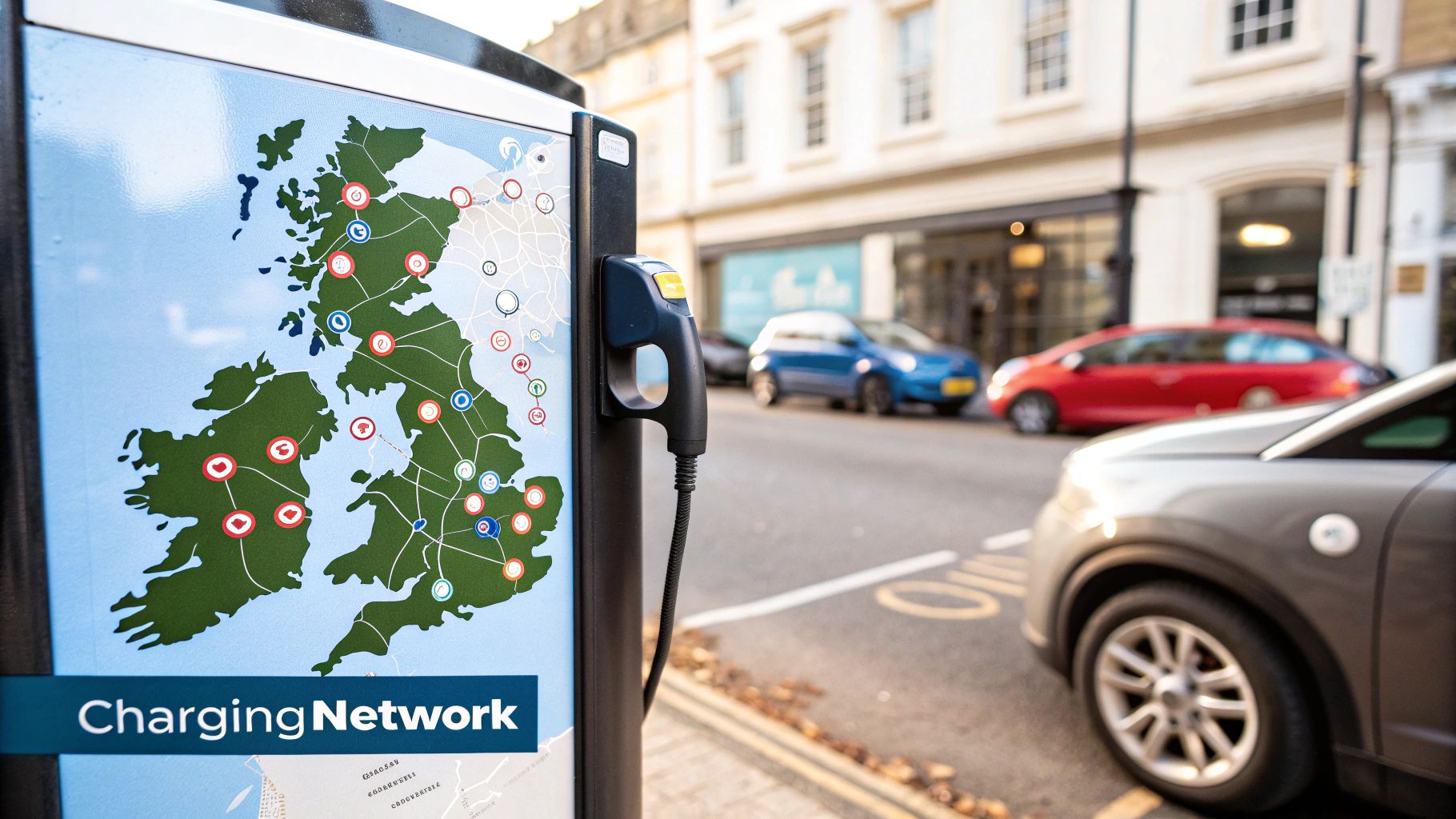
Knowing your CCS from your CHAdeMO is a great start but the other half of the puzzle is actually finding a compatible charger when you’re out on the road. The good news? The UK’s public charging network is growing at an incredible rate, making it easier than ever to own an EV without a hint of range anxiety.
This rapid expansion means chargers are popping up everywhere you’d expect—and some places you might not. Motorway services now host powerful rapid charging hubs while supermarkets, public car parks and even lampposts are being fitted with convenient chargers. This growth is a direct response to the rising number of EVs on the road, ensuring the infrastructure keeps pace with driver demand.
The statistics paint a very reassuring picture. As of April 2025 the UK had 76,507 publicly available EV charging devices, which is a 28% increase in just one year. This network is a healthy mix of speeds with 15,446 powerful units of 50kW or above for quick top-ups and 42,874 slower chargers for longer stays.
Charger Types For Different Needs
When you pull into a charging location you’ll likely find different types of chargers designed for specific situations. Understanding what to expect helps you plan your journey and charging stops more effectively.
You can break the network down into two main categories:
- Destination Chargers: These are the slower AC units you find where you’re likely to park for a while, like at a supermarket, shopping centre or hotel. They’re perfect for adding a significant amount of range over an hour or two while you go about your business.
- En-Route Chargers: These are the high-power DC rapid and ultra-rapid chargers found along major routes like motorways. They are built for speed, designed to get you topped up and back on your journey as quickly as possible.
The Ever-Growing Network
This expanding web of chargers makes long-distance travel in an EV a simple and stress-free experience. The days of anxiously planning a route around the handful of available charging points are disappearing fast.
The real change is psychological. With chargers becoming a common sight at familiar places like the weekly supermarket or local gym, EV ownership is moving from being a specialist choice to a practical, everyday option for millions of people.
Of course, beyond the specifics of charging, those planning a trip might find it useful to prepare in other ways. You can explore some general travel considerations for the UK here. This constant improvement in infrastructure means that wherever you're heading you can be confident that a compatible charger is never too far away.
Navigating Regional Gaps in Charging Access
While national figures paint a rosy picture of the UK’s growing charging network the day-to-day reality can feel very different depending on your postcode. An EV driver’s experience in central London is worlds apart from someone trying to top up in rural Wales or Northern Ireland.
This disparity, often called a ‘postcode lottery’, isn’t just a fluke. It's the result of several intertwined factors including local government investment, population density and straightforward commercial viability. Cities with high EV uptake and proactive councils naturally attract more attention from charging operators, creating a cycle that can leave other areas behind.
The London Effect
Greater London is without a doubt the epicentre of the UK’s charging infrastructure. It’s home to over 25,502 public EV charging devices, making up roughly 30% of the entire UK network.
When you break it down per person the capital boasts 263 devices for every 100,000 people—more than double the national average of 113. If you're interested in the numbers you can discover more insights about UK charging statistics.
At the other end of the scale Northern Ireland has the scarcest provision, with just 35 devices per 100,000 people. This massive gap highlights the challenge for drivers outside major urban hubs and shows why getting to know your local network is so vital.
Bridging the Infrastructure Gap
Fortunately this imbalance hasn’t gone unnoticed. A number of initiatives are now underway to level the playing field and make sure that no driver gets left behind, regardless of where they live.
Key initiatives include:
- Government Funding: Programmes like the Local EV Infrastructure (LEVI) Fund are funnelling millions of pounds to councils to boost public charging, especially on-street options for residents without driveways.
- Private Investment: Major network operators are finally expanding into less-served regions, recognising the growing market and the need to build a truly national network.
- Targeted Projects: Efforts are underway to install rapid charging hubs along key motorways and in more remote areas, directly tackling range anxiety for long-distance travellers.
The goal is simple: to make sure that finding a reliable electric car charging plug is just as easy in the Scottish Highlands as it is in South London. Closing this gap is not just about convenience; it's about making electric vehicles a practical choice for every driver in the country.
Common Questions About EV Charging Plugs
As the world of electric vehicles keeps expanding it's only natural for drivers to have questions. From adaptors to what the future holds for electric car charging plugs, let’s clear up some of the most common queries.
Can I Use Adaptors for Different Plug Types?
Yes, adaptors are widely available but they come with some important limits. A common—and perfectly safe—use is adapting a Type 1 car to connect to a Type 2 charging point. Simple enough.
However, you absolutely cannot adapt between the two main rapid charging standards. A CHAdeMO car just won't work with a CCS charger or vice versa, no matter what adaptor you find.
Always buy your adaptors from a reputable supplier and triple-check that they’re compatible with both your car and the charger you plan to use.
What Is the Difference Between AC and DC Charging?
Think of AC (Alternating Current) as the raw electricity that comes from the National Grid into your home. Your car has a clever onboard charger that converts this AC power into DC (Direct Current) so it can be stored in the battery. This conversion process is why AC charging is slower and perfect for overnight top-ups at home.
DC rapid chargers, on the other hand, are a different beast entirely. They are much more powerful because they bypass your car's onboard converter and feed DC power directly into the battery. This direct approach is why they can add hundreds of miles of range in under an hour, making them a lifesaver on long journeys.
For a deeper dive into the terminology you can explore our comprehensive EV charging glossary.
Will the UK Get a Single Charging Standard?
The industry is already moving decisively towards one. For AC charging the Type 2 plug is now the established norm across the UK and Europe.
When it comes to rapid DC charging CCS is the clear winner. Almost every new electric car sold here now features a CCS port. While you'll still see CHAdeMO-equipped cars on our roads for years to come the future is firmly set on the CCS standard.
While our main focus here is on the plugs that power your car we know EV ownership brings other questions. For an essential guide on another vital component you might find valuable insights into Electric Car Key Replacement.
Struggling with fixed charging points? ZAPME brings the power to you with our mobile EV charging solutions, ensuring you're never left stranded. https://www.zapme.biz

